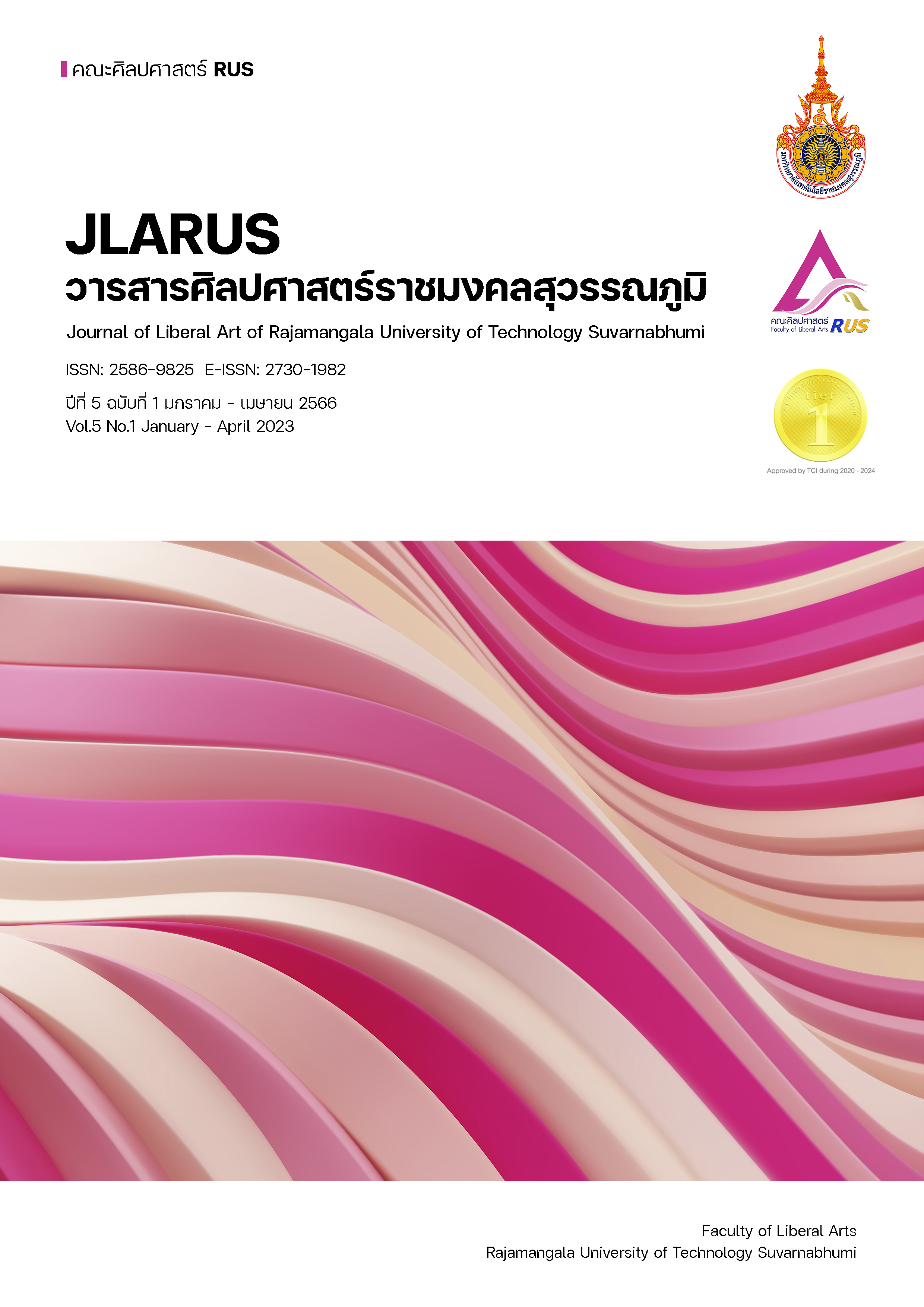A STUDY OF ENGLISH LANGUAGE LEARNING STRATEGIES OF STUDENTS AT RAJAMANGALA UNIVERSITY OF TECHNOLOGY SUVARNABHUMI SUPHANBURI CAMPUS
Main Article Content
Abstract
The purposes of this research were (1) to study the English language learning strategies of students at Rajamangala University of Technology Suvarnabhumi, Suphanburi campus, and (2) to compare the English language learning strategies used by the students based on their genders and faculties. Quantitatively, the sample was the student's Rajamangala University of Technology Suvarnabhumi, Suphanburi campus who were chosen by stratified sampling. The sample for t-test was 283 students, and one-way analysis of variance was 407 students. The quantitative research instrument was the Strategies Inventory of Language Learning (SILL, version 7.0) by Oxford (1990). The SILL was translated into Thai and adapted to suit a Thai context. The SILL consists of 50 items measuring six language learning strategies: memory, cognitive, compensation, metacognitive, affective, and social. The data was analyzed using arithmetic means, standard deviation, t-test, one-way analysis of variance, and a multiple comparison test (Bonferoni’s Test).
The results were as follows: 1) The students moderately used English language learning strategies in all categories. When considering each side and sort by most to mean less as follows: Metacognitive Strategies, Social Strategies, Cognitive Strategies, Compensation Strategies, Memory Strategies, and Affective Strategies. 2) The males and females used English language learning strategies differently at a significance level of .05. Their showed females used English language learning strategies more than males by considering each side. And 3) The students studied different faculties used English language learning strategies differently at a significance level of .05. The results of pair difference showed that the students used English language learning strategies were the same pattern to use each side.
Article Details

This work is licensed under a Creative Commons Attribution-NonCommercial-NoDerivatives 4.0 International License.
References
กชพร ทองประไพ. (2548). ความสัมพันธ์ระหว่างกลวิธีการเรียนภาษากับผลสัมฤทธิ์ทางการเรียน วิชาภาษาอังกฤษระหว่างนักเรียนชั้นมัธยมศึกษาปีที่ 6 (วิทยานิพนธ์ปริญญาศิลปศาสตร มหาบัณฑิต สาขาภาษาอังกฤษ คณะมนุษยศาสตร์). พิษณุโลก: มหาวิทยาลัยนเรศวร.
ชาญณรงค์ อินทรประเสริฐ. (2546) การใช้กลวิธีการเรียนภาษาอังกฤษนอกชั้นเรียนของนักศึกษามหาวิทยาลัยเทคโนโลยีสุรนารี. กรุงเทพมหานคร: สำนักงานคณะกรรมการวิจัยแห่งชาติ (วช.).
ทวีศักดิ์ ขันยศ. (2560). การศึกษากลวิธีการเรียนภาษาอังกฤษของนักศึกษาชั้นปีที่ 1 มหาวิทยาลัยราชภัฏพิบูลสงคราม. กรุงเทพมหานคร: สำนักงานคณะกรรมการวิจัยแห่งชาติ (วช.).
แพรวพรรณ พริ้งพร้อม. (2549). การศึกษาการใช้กลยุทธ์การเรียนภาษาอังกฤษของนักศึกษามหาวิทยาลัยกรุงเทพ ชั้นปีที่ 1 และชั้นปีที่ 2. วารสาร BU Academic Review, 8(2), 15-26.
สุดารัตน์ พญาพรหม. (2543). การศึกษาความสัมพันธ์ระหว่างกลวิธีที่ใช้ในการฟังและความสามารถในการฟังภาษาอังกฤษของนิสิตวิชาเอกภาษาอังกฤษ ชั้นปีที่ 4 มหาวิทยาลัยศรีนครินทรวิโรฒ. (ปริญญานิพนธ์ศึกษาศาสตรมหาบัณฑิต สาขาวิชาภาษาอังกฤษ). กรุงเทพมหานคร: บัณฑิตวิทยาลัย มหาวิทยาลัยศรีนครินทรวิโรฒ.
Bremner, S. (1990). Language learning strategies and language proficiency: investigating the relationship in Hong Kong. Hong Kong.
Clouston, L.M. (1997). Language learning strategies: An overview for teachers. Retrieved August 26, 2011. from http://itestj.org/Articles/Lesard-Clouston-Strategy.htm.
Cunningham, F. (2000). “The Plot Thickens: Beginning Level English Language Learners as Strategies. Practical Research Briefs, 1999-2000 Report Series,”. Learning Strategies. 28(3), 56-57.
Emily Edward. (2015). Seeking out challenges develop self-confidence: A languages learner’s journey to proficiency. The electronic journal for English as a second language. 18(4), 1.
Green, J. & Oxford, R.L. (1995). A closer look at learning strategies, Proficiency and Gender. TESOL Quarterly, 29(Summer 1995), 261-297.
Kaylami, C. (1996). The influence of gender and motivation on EFL learning strategy use in Jordan. In Rebacca L. Oxford (Ed.) Language learning strategies around the world: Cross-cultural perspectives (pp.75-88). Honolulu: University of Hawaii, Second Language Teaching & Curriculum center.
Oxford, R.L. & Ehrman, M.E. (1995). Adults’ Language Learning Strategies in an Intensive Foreign Language Program in the United States. System. 23(3), 359-386.
Oxford, R.L., & Nyikos, M. (1989). Variables affecting choice of language learning strategies by university students. Modern Language Journal, 73(3), 291-300.
Oxford, Rebacca L. (1990). Language Learning strategies: What Every Teacher Should Know. New York: Newbury House.
Stern, H.H. (1983). Fundamental concepts of language teaching. Oxford: Oxford University.
Wenden, A. (1998). Learner strategies for learner autonomy: Planning and implementing learner training for language learner. New York: Prentice Hall.
Yamith Jose Fandino. (2013). “21st Century Skills and the English Foreign Language Classroom: A Call for More Awareness in Columbia. Gist Education and Learning,”. Research Journal. 7(2013), 190-208.


